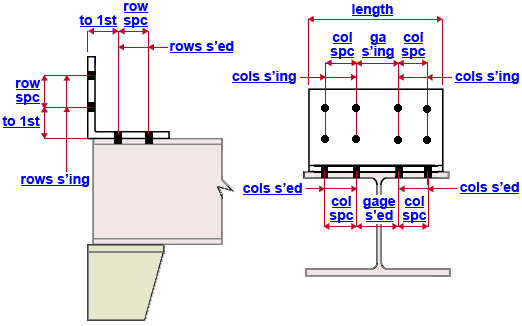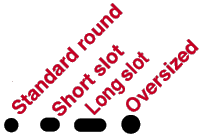"  Top Flange Stability Angle " connection design locks
Top Flange Stability Angle " connection design locks
| A " |
|
|||
"  |
|
||
User Defined Connections: Settings that are locked (
) in a user defined connection file will automatically be locked on a member edit window for which that file is the " Input connection type ." You can, if you so choose, manually lock additional settings on the member edit window, and your changes will be retained, through multiple processes, so long as you do not change to a different connection then switch back to the original user defined connection.
Beam Edit: To change a setting, first set it to locked (
). Related settings that are unlocked (
) may be updated, and the "
Left/Right end limit state " calculations will be updated. Settings that are locked (
) will not be changed by connection design , even if doing so might prevent a connection failure.
Connection design locks :
| Locks not dimensioned or called out on the drawing are marked ( not depicted ). |
![]() Top Flange Stability Angle
Top Flange Stability Angle
Angle size and orientation
Material ( not depicted ): The section size of the angle material to be used for the top flange stability angle. For example, L4x3x5/16. The section size you enter here must exist in the local shape file and must be an angle, or connection design will not accept your entry. To enter an angle section size, you can type in the section size that you want, or you can press the "file cabinet" browse button (
) and double-click any section that is on the list of available angles in the local shape file .
Long leg to ( not depicted ): Supported or Supporting . If you want the long leg of the angle to attach to the supporting column, select ' Supporting '. If you want the long leg of the angle to attach to the supported beam, select ' Supported '.
Angle length ( length ): The length that you want the angle to be cut to. This is the distance between the near side edge and far side edge of the angle. See the example .
Bolt diameter ( not depicted ): You can either type in any diameter (inches or mm), or you can select a bolt diameter from the combo box (
). The diameters that are listed in the combo box come from Home > Project Settings > Job > Bolt Settings > the " Available bolt diameters " list. The bolt diameter selected here, together with the supported " Hole type " and supporting " Hole type ," set the diameter of holes the bolts go into.
Supported
Hole type ( not depicted ): Standard round or Short slot or Oversized or Long slot or User slot #1 or User slot #2 . The hole type selected here, together with the " Bolt diameter " entered below, set the diameter of holes on the leg of the angle that bolts to the supported beam.

Rows ( rows s'ed ): The number of rows of holes in the leg of the restraining angle that bolts to the top flange of the supported beam. In the example above, the number of these rows is ' 2 '.
Horizontal to 1st hole ( to 1st ): The distance from the heel of the angle to the center of the first row of holes on the angle leg to the top flange of the supported beam. This distance is parallel with the work line of the beam, horizontal if the column is perfectly vertical and the beam is not sloping. See the example shown.
Row spacing ( row spc ): The distance (center to center) between rows of holes in the leg of the angle that bolts to the top flange of the supported beam (see example ).
Columns ( cols s'ed ): Half of the total number of columns of holes in the leg of the stability angle that bolts to the top flange of the supported beam. In other words, this is the total number of columns of holes for the near side or far side of the beam. In the example above, the number of these rows is ' 2 ' since the total number of columns of holes to the supported beam is ' 4 '.
Gage ( gage s'ed ): The distance (center to center) between the two columns of holes that are closest to the work line of the supported beam (the two inside columns of holes on the angle leg to the beam). See the example .
Column spacing ( col spc ): The distance (center to center) between any two adjacent columns of holes that are on the same side (near side or far side) of the work line of the supported beam (see example ).
Supporting
Hole type ( not depicted ): Standard round or Short slot or Oversized or Long slot or User slot #1 or User slot #2 . The hole type selected here, together with the " Bolt diameter " entered below, set the diameter of holes on the leg of the angle that bolts to the supporting column.

Rows ( rows s'ing ): The number of rows of holes in the leg of the angle that bolts to the supporting column. In the example above, the number of these rows is ' 2 '.
Vertical to 1st hole ( to 1st ): The distance from the heel of the angle to the center of the first row of holes on the angle leg to the supporting column (see example ).
Row spacing ( row spc ): The distance (center to center) between rows of holes in the angle leg to the column (see example ).
Columns ( cols s'ing ): Half of the total number of columns of holes in the leg of the stability angle that bolts to the supporting column. In the example above, the number of these columns is ' 2 ' and the total number of columns to the supporting member is ' 4 '.
Gage ( ga s'ing ): The distance (center to center) between the two inside columns of holes on the angle leg to the supporting column (see example ).
Column spacing ( col spc ): The distance (center to center) between any two adjacent columns of holes that are on the same side (near side or far side) of the angle leg to the supporting column (see example ).







